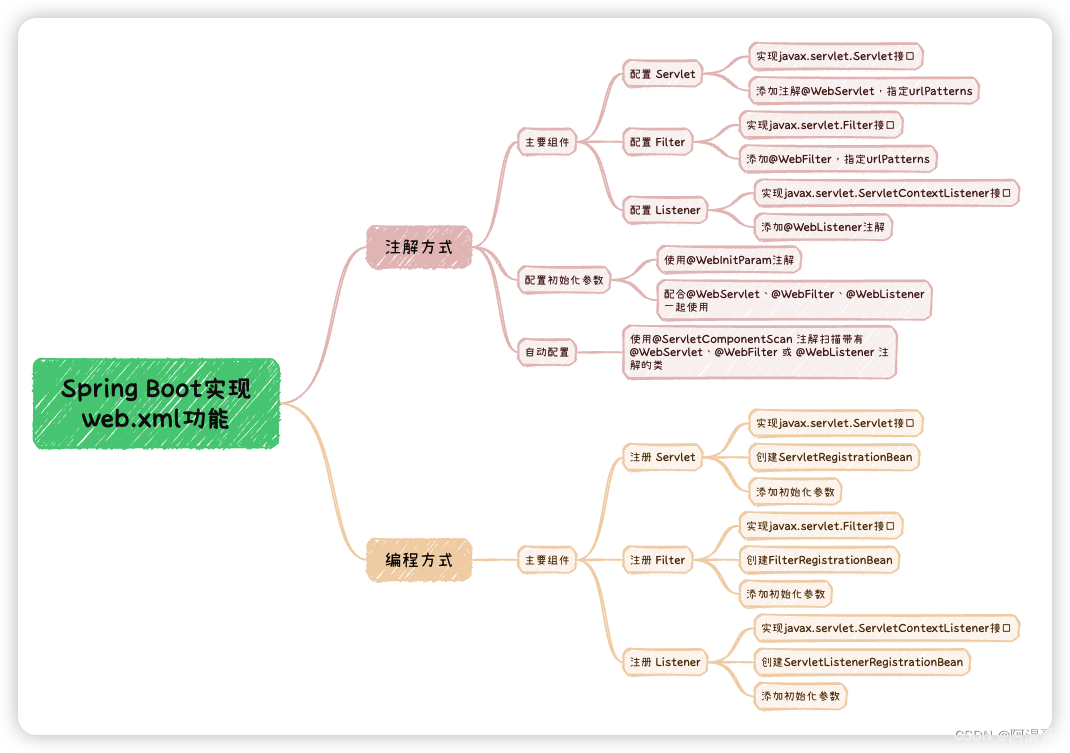Spring Boot实现web.xml功能

在Spring Boot中,不再需要使用传统的 web.xml 文件来配置web应用的功能,Spring Boot支持通过注解和基于代码两种方式来实现web.xml的功能。本文主要介绍这两种方法的实现。
1. 基于注解实现
在 Spring Boot 中,不再需要使用传统的 web.xml 文件来配置 Web 应用的功能。Spring Boot 使用基于注解的配置和自动配置来简化 Web 应用的开发和部署。
以下是一些常见的 web.xml 配置及其在 Spring Boot 中的替代方案:
-
配置 Servlet:
- 在 Spring Boot 中,可以通过创建一个类并继承
javax.servlet.Servlet接口来定义 Servlet。然后,使用@WebServlet注解将其标记为 Servlet,并指定 URL 映射。
- 在 Spring Boot 中,可以通过创建一个类并继承
-
配置 Filter:
- 在 Spring Boot 中,可以通过创建一个类并实现
javax.servlet.Filter接口来定义 Filter。然后,使用@WebFilter注解将其标记为 Filter,并指定 URL 模式。
- 在 Spring Boot 中,可以通过创建一个类并实现
-
配置 Listener:
- 在 Spring Boot 中,可以通过创建一个类并实现
javax.servlet.ServletContextListener接口来定义 Listener。然后,使用@WebListener注解将其标记为 Listener。
- 在 Spring Boot 中,可以通过创建一个类并实现
-
配置初始化参数:
- 在 Spring Boot 中,可以使用
@ServletComponentScan注解扫描带有@WebServlet、@WebFilter或@WebListener注解的类,并使用@WebInitParam注解来指定初始化参数。
- 在 Spring Boot 中,可以使用
总的来说,Spring Boot 鼓励使用基于注解的方式来配置和管理 Web 应用的功能,以简化开发和减少配置文件的使用。通过使用注解,可以在类级别上直接标记 Servlet、Filter 和 Listener,并以更直观的方式指定它们的配置和映射。
1.1 组件注册
以下是一个示例,展示了如何在 Spring Boot 中使用注解来配置 Servlet、Filter 和 Listener:
- 创建一个 Servlet:
import javax.servlet.annotation.WebServlet;
import javax.servlet.http.HttpServlet;
import javax.servlet.http.HttpServletRequest;
import javax.servlet.http.HttpServletResponse;
import java.io.IOException;
@WebServlet(urlPatterns = "/hello")
public class HelloServlet extends HttpServlet {
@Override
protected void doGet(HttpServletRequest req, HttpServletResponse resp) throws IOException {
resp.getWriter().println("Hello, World!");
}
}
- 创建一个 Filter:
import javax.servlet.annotation.WebFilter;
import javax.servlet.*;
import java.io.IOException;
@WebFilter(urlPatterns = "/hello")
public class HelloFilter implements Filter {
@Override
public void doFilter(ServletRequest request, ServletResponse response, FilterChain chain) throws IOException, ServletException {
System.out.println("Before HelloServlet");
chain.doFilter(request, response);
System.out.println("After HelloServlet");
}
}
- 创建一个 Listener:
import javax.servlet.annotation.WebListener;
import javax.servlet.ServletContextEvent;
import javax.servlet.ServletContextListener;
@WebListener
public class HelloListener implements ServletContextListener {
@Override
public void contextInitialized(ServletContextEvent servletContextEvent) {
System.out.println("Web application initialized");
}
@Override
public void contextDestroyed(ServletContextEvent servletContextEvent) {
System.out.println("Web application destroyed");
}
}
在上述示例中,我们使用了 @WebServlet、@WebFilter 和 @WebListener 注解来标记 Servlet、Filter 和 Listener。通过 urlPatterns 属性,我们指定了 Servlet 和 Filter 的 URL 映射。
请注意,为了使注解生效,还需要在启动类上添加 @ServletComponentScan 注解,以扫描并加载带有注解的 Servlet、Filter 和 Listener:
import org.springframework.boot.SpringApplication;
import org.springframework.boot.autoconfigure.SpringBootApplication;
import org.springframework.boot.web.servlet.ServletComponentScan;
@SpringBootApplication
@ServletComponentScan
public class YourApplication {
public static void main(String[] args) {
SpringApplication.run(YourApplication.class, args);
}
}
这样,你就可以在 Spring Boot 中使用注解来配置和管理 Servlet、Filter 和 Listener,而不再需要使用传统的 web.xml 文件。
1.2 @WebInitParam注解
使用 @WebInitParam 注解可以在 Servlet、Filter 或 Listener 上指定初始化参数。下面是一个示例,展示了如何使用 @WebInitParam 来设置初始化参数:
- 创建一个 Servlet 并设置初始化参数:
import javax.servlet.annotation.WebServlet;
import javax.servlet.http.HttpServlet;
import javax.servlet.http.HttpServletRequest;
import javax.servlet.http.HttpServletResponse;
import java.io.IOException;
@WebServlet(urlPatterns = "/hello", initParams = {
@WebInitParam(name = "message", value = "Hello, World!"),
@WebInitParam(name = "count", value = "5")
})
public class HelloServlet extends HttpServlet {
@Override
protected void doGet(HttpServletRequest req, HttpServletResponse resp) throws IOException {
String message = getInitParameter("message");
int count = Integer.parseInt(getInitParameter("count"));
for (int i = 0; i < count; i++) {
resp.getWriter().println(message);
}
}
}
在上述示例中,我们使用 @WebServlet 注解为 Servlet 指定了两个初始化参数:message 和 count。可以使用 getInitParameter() 方法在 Servlet 中获取这些初始化参数的值。
- 在启动类上添加
@ServletComponentScan注解:
import org.springframework.boot.SpringApplication;
import org.springframework.boot.autoconfigure.SpringBootApplication;
import org.springframework.boot.web.servlet.ServletComponentScan;
@SpringBootApplication
@ServletComponentScan
public class YourApplication {
public static void main(String[] args) {
SpringApplication.run(YourApplication.class, args);
}
}
- 运行应用并访问
/hello路径,将输出初始化参数指定的消息多次:
Hello, World!
Hello, World!
Hello, World!
Hello, World!
Hello, World!
通过使用 @WebInitParam 注解,并在对应的 Servlet、Filter 或 Listener 上指定初始化参数,你可以方便地设置和获取这些初始化参数的值。这样,你就可以在应用程序中使用这些参数来进行相应的逻辑处理。
2. 基于编码实现
2.1 Servlet & Filter
除了使用注解的方式,还有一种方式可以在 Spring Boot 中实现 web.xml 的功能,即通过编写一个 ServletRegistrationBean 或 FilterRegistrationBean 的 Bean 来注册 Servlet 或 Filter。
以下是使用 ServletRegistrationBean 注册 Servlet 的示例:
import org.springframework.boot.web.servlet.ServletRegistrationBean;
import org.springframework.context.annotation.Bean;
import org.springframework.context.annotation.Configuration;
@Configuration
public class ServletConfig {
@Bean
public ServletRegistrationBean<HelloServlet> helloServletRegistrationBean() {
ServletRegistrationBean<HelloServlet> registrationBean = new ServletRegistrationBean<>(new HelloServlet(), "/hello");
registrationBean.addInitParameter("message", "Hello, World!");
registrationBean.addInitParameter("count", "5");
return registrationBean;
}
}
在上述示例中,我们创建了一个 ServletRegistrationBean 的 Bean,并将自定义的 HelloServlet 类设置为 Servlet。然后,使用 addInitParameter 方法指定初始化参数的名称和值。
类似地,你可以使用 FilterRegistrationBean 注册 Filter。以下是一个使用 FilterRegistrationBean 注册 Filter 的示例:
import org.springframework.boot.web.servlet.FilterRegistrationBean;
import org.springframework.context.annotation.Bean;
import org.springframework.context.annotation.Configuration;
@Configuration
public class FilterConfig {
@Bean
public FilterRegistrationBean<HelloFilter> helloFilterRegistrationBean() {
FilterRegistrationBean<HelloFilter> registrationBean = new FilterRegistrationBean<>(new HelloFilter());
registrationBean.addUrlPatterns("/hello");
return registrationBean;
}
}
在上述示例中,我们创建了一个 FilterRegistrationBean 的 Bean,并将自定义的 HelloFilter 类设置为 Filter。然后,使用 addUrlPatterns 方法指定要过滤的 URL 模式。
通过使用 ServletRegistrationBean 和 FilterRegistrationBean,你可以在 Spring Boot 中以编程方式注册 Servlet 和 Filter,并设置相应的初始化参数和 URL 模式。
需要注意的是,如果你的 Servlet 或 Filter 类是通过 @Component 或 @Bean 注解进行注入的,Spring Boot 会自动将其作为 Servlet 或 Filter 进行注册。如果你的 Servlet 或 Filter 类不是由 Spring 管理的 Bean,你可以使用 ServletRegistrationBean 或 FilterRegistrationBean 手动注册。
2.2 Listener
以下是一个示例代码,展示了如何使用ListenerRegistrationBean来注册一个Listener:
import org.springframework.boot.web.servlet.ServletListenerRegistrationBean;
import org.springframework.context.annotation.Bean;
import org.springframework.context.annotation.Configuration;
@Configuration
public class MyListenerConfig {
@Bean
public ServletListenerRegistrationBean<MyListener> myListenerRegistrationBean() {
ServletListenerRegistrationBean<MyListener> registrationBean = new ServletListenerRegistrationBean<>(new MyListener());
return registrationBean;
}
}
在上面的示例中,我们通过创建一个ServletListenerRegistrationBean的实例来注册一个MyListener。这里不需要指定URL映射,因为Listener不是通过URL访问的。
类似于ServletRegistrationBean和FilterRegistrationBean,ListenerRegistrationBean也提供了一些可配置的选项,例如顺序、初始化参数等。可以根据具体的需求进行配置。
通过使用ListenerRegistrationBean,我们可以方便地在Spring应用程序中注册和配置Listener,而无需依赖于web.xml文件。
3. 总结
通过上述介绍我们了解到,在Spring Boot应用中,我们可以通过注解和编程两种方式实现web.xml的功能,包括如何创建及注册Servlet、Filter以及Listener等。至于具体采用哪种方式,大家可以根据自己的喜好自行选择。






















 2356
2356

 被折叠的 条评论
为什么被折叠?
被折叠的 条评论
为什么被折叠?








